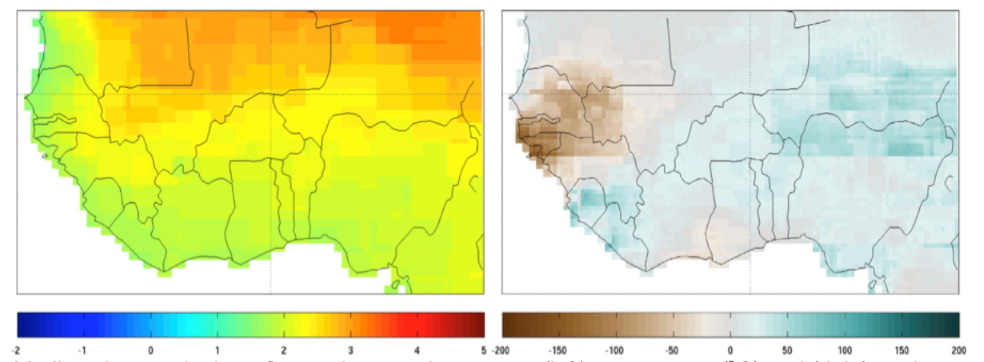Climate
West Africa is projected to experience substantial warming and shifts in precipitation during the critical June-September growing season. The map below (left) shows temperature increases (in a high emissions scenario) from 1.0-2.5 C by the 2050s. These impacts will be even greater for Senegal's inland and arid regions. The map (right) shows projected rainfall changes. These are more uncertain but indicate drier median conditions in the west (up to a 20% decline in rainfall) and slightly wetter conditions in the east (up to 10% increase).

Economy
The Senegalese agricultural sector is low in productivity and the country is food-deficit. Over the last ten years, domestic production has covered between 30% and 65% of annual cereal needs. Imported rice, wheat, and maize have covered the remaining gap (ANSD, 2016).Income poverty is high in the region; although efforts and policies over the last decade have lowered the poverty rate to 46.7% in 2011. Poverty is more pronounced in rural areas with an incidence of 57.1% compared to 26.1% in Dakar (PSE, 2014).
Agricultural Production Systems
Agriculture is dependent on climate conditions and is mostly dominated by smallholder farmers. The main crops grown are related to groundnut, cereals (millet, maize, rice, sorghum, etc) and horticulture (onion, tomato, potato, etc). Livestock accounts for 4.3% of the GDP and is practiced by 29.5% of households (République du Sénégal, 2020a). In 2019, national meat production was estimated at 267 358 tons while milk production was 264.4 millions of liter (ANSD, 2019). However, climate change has induced challenges in agricultural performance. The decrease in rainfall and the recurrence of extreme events (droughts) resulted in a decline in agricultural productivity and farmers’ livelihoods.


